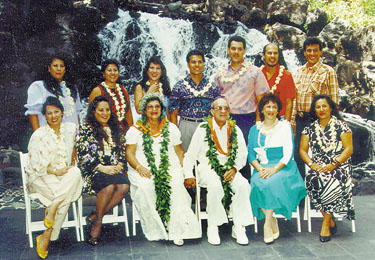 |
| A family photo taken in 1995 at the Kahala Hilton to celebrate the parents’ 50th wedding anniversary.
• Meet the Inciongs |
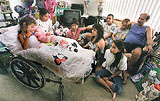 |
| Henry "Hanalei" Inciong, who shares a home in Whitmore Village with his wife, daughter and five grandchildren, finds it difficult to reflect on larger issues amid family concerns. His granddaughter Kassandra, 6, had both her legs broken in an accident.
Deborah Booker • The Honolulu Advertiser
|
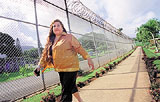 |
| Ke‘alaaumoe Inciong-Ako, an education program supervisor at the Women’s Community Correctional Facility in Kailua, has been a Hawaiian activist since the 1970s. She was "incensed" by the idea of Rice vs. Cayetano.
Bruce Asato • The Honolulu Advertiser
|
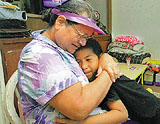 |
| Ellen Inciong, matriarch of the Inciong family, hugs her grrandson Kaianui at her daughter’s home, which also serves as a day-care center.
Deborah Booker • The Honolulu Advertiser
|
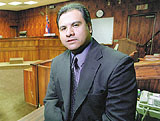 |
| Lopaka Inciong, a clerk for Circuit Court Judge Rey Graulty, believes he can advance the cause of Hawaiians more effectively by working within the Western legal system.
Bruce Asato • The Honolulu Advertiser
|
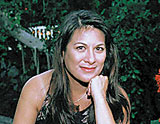 |
| Leona Lawhead, a hotel lounge singer, believes in evolving with the culture and showing that Hawaiians are survivors.
Bruce Asato • The Honolulu Advertiser |
The State of a Family
By Dan Nakaso
Advertiser Staff Writer
Her grandfather was slapped for speaking the language of his people. Her parents were children when they were told that Hawaiians like them were a lazy, shiftless race.
And so Melissa Andaya, three-eighths Hawaiian and adept at only a few Hawaiian phrases, struggled to translate a note in Hawaiian from her son’s school written in the big looping letters of a 7-year-old’s hand.
The fact that Andaya’s son, Kaianui, is learning Hawaiian through an immersion program at Waiau Elementary School returns a small part of the ancestry denied to three generations of her family.
Andaya, 37, grew up in Wahiawa in a family of 11 brothers and sisters. The children of Ellen and David Inciong remember their father going for years without a new pair of shoes to help save money to send them all to private schools.
But the Inciongs never lacked for pride in their Hawaiian blood - or outrage about the way Hawaiians were treated in the Islands.
Politics brought home
Today the 11 Inciong children have children of their own, and have migrated throughout the Islands from Kona to Kapa‘a, and on the Mainland from California to the East Coast.
They are hula moms, entertainers, laborers and mentors to the next generation of Hawaiians. They are, in essence, the reflection of Hawaiian families who protested, pondered or even ignored the extraordinary series of events that shaped Hawaiian issues last year.
The U.S. Supreme Court’s decision in Rice vs. Cayetano. Sen. Daniel Akaka’s bill allowing Hawaiians to set up their own government. The changing makeup of the Office of Hawaiian Affairs.
None of the often stunning political developments that unfolded for Hawaiians in the year 2000 has changed the lives of the Inciong children directly. At least not yet.
But the level of awareness and interest varied from sister to sister, brother to brother, molded in part by their ages, occupations and the pressures of career and family.
Andaya runs a day-care center in the Waipahu home she shares with her mother. Baby brother Lopaka clerks for a Circuit Court judge. Sister Moana Balaz works as an academic counselor helping Hawaiian students at Kamehameha Schools and the University of Hawai‘i. Ke‘alaaumoe Inciong-Ako runs the education program at the Women’s Community Correctional Center. Keoni teaches Hawaiian immersion on Kaua‘i.
"Many times over the last year I felt outraged about what was happening, and would have liked to take part and be more active in Hawaiian issues," said one of the middle sisters, Malia Beaver, a 44-year-old paralegal from Makakilo.
"There’s always that guilt factor of not becoming more involved and not being more committed," she said. "But my time is so full of having to take care of my own kids and raising my family and trying to survive. Those things are important. Because it has always been a basic thought of mine that as a Hawaiian, I could not fail."
Making history
Her brother Keoni turned the unfolding events into civics lessons at Kapa‘a High School, where he teaches Hawaiian immersion.
"Most of my students come from Hawaiian homelands, and all of them are Hawaiian," Keoni said. "When we talk about U.S. history, this is a great teaching tool."
The events of the last year were much more than an academic exercise for Keoni, 39.
He organized co-workers and friends to go with him to the Akaka hearings. He also attended the Hawaiian reconciliation hearings that the Clinton Administration held across the state in the fall of 1999, a precursor to the political turmoil of 2000.
"We’re out there when there are issues that touch us," he said.
Keoni worries that fallout from the Supreme Court’s ruling in Rice vs. Cayetano could jeopardize other programs designed for Hawaiians, such as the Hawaiian immersion program he teaches.
His wife Debora, who is more than 50 percent Hawaiian, is on the waiting list for Hawaiian homelands. The Inciong children, by contrast, are just one-eighth shy of meeting the Department of Hawaiian Homelands’ minimum requirement of 50 percent Hawaiian blood.
"Not all Hawaiians need help," Keoni said. "But some do. And when it comes to the Rice decision, that could just change the whole mission of Hawaiian programs, or eliminate them."
He remembers tagging along with his older sister, Ke‘alaaumoe, when she went to Hawaiian studies lectures at UH or to protests over water rights in Waiahole.
Cultural pioneer
Inciong-Ako, 49, was part of the wave of activists who helped usher in Hawai‘i’s cultural renaissance in the 1970s that changed the face of politics, hula, sea voyaging, language and nearly every other shade of life in the Islands.
Today she continues to work with Hawaiians as the education program supervisor for the Women’s Community Correctional Center in Kailua. And she is the only supervisor in the Department of Public Safety’s education program with Hawaiian blood.
"I am incensed with rage at the idea of Rice vs. Cayetano," Inciong-Ako said. "I’m very optimistic about us as a Hawaiian community, but totally disenchanted that people still do not recognize that this is Hawai‘i, and as Native Hawaiians we have no other place to go. This is our land."
She traces her passion back to her maternal grandfather, Luther Ambrose Kawelookamahamahaiaonakaihauliuliokapakipika Pu‘ulei, who gave his grandchildren pride in their Hawaiian blood.
"He would speak Hawaiian and get slapped in the face or punched in the head by the haole teachers," said the oldest Inciong sibling, Alexandrina "Ho‘oipo" Orth, 58, who lives in the town of Riverbank, in California’s Central Valley. "They were told it was the devil language. It would tear my heart to think my grandfather would get lickings for speaking his language."
Grandfather Pu‘ulei was held up throughout their lives as a symbol of Hawaiian family and strength. Nearly 40 years later, Beaver can still remember a lesson before her first day of school even began.
"As I was getting ready for school, my mother asked me whether I was proud of my grandfather. She said, ‘Do you love him?’ I said, ‘Oh yes, mommy.’ And she said, ‘Just remember that you must always do your very best because you don’t want people to laugh at your papa. What you do reflects on him and reflects on all Hawaiians.’ "
Change from within
Baby brother Lopaka, 34, was too young to get much time with his grandfather.
As an adult, he couldn’t attend any of the reconciliation hearings. He was too busy studying for finals at UH’s William S. Richardson School of Law.
Lopaka is now a clerk for Circuit Court Judge Rey Graulty. He isn’t sure exactly what kind of law he wants to practice, other than litigating Native Hawaiian issues.
Rather than protesting decisions like Rice vs. Cayetano, Lopaka believes he can be more effective working within the U.S. legal system.
"It is conforming to the mainstream," he said. "That’s OK, because the political views that were real radical in the ’70s with my older sisters and brothers have now taken hold with the public."
Still, Lopaka said, there is so much work to be done.
The other night, talking with his 7-year-old daughter Tiani about Queen Liliu‘okalani, Hawai‘i’s last reigning monarch, it became clear to Lopaka that even her Hawaiian immersion schooling at Kula Kaiapuni ‘O Pu‘ohala in Kane‘ohe left some gaps.
Tiani speaks Hawaiian fluently and knows something about the 1893 overthrow of the kingdom. But she believed Hawai‘i became part of the United States simply because there were no more ali‘i left to rule. When he gently touched on the issues of the armed overthrow and the role of American business interests, Tiani’s eyes grew wide with understanding.
"She was kind of surprised," Lopaka said. "That’s the normal response of many people who don’t know the history of the Hawaiian kingdom and the overthrow."
Survival what matters
His older sister, Leona Ann Lokelani Lawhead, 45, says she meets tourists along the Big Island’s Kohala Coast who haven’t gotten even that far in their understanding of Hawaiian history.
And they won’t learn it from Lawhead, who refuses to hint at how strongly she feels. As a hotel lounge singer, she doesn’t feel it’s her place.
After the Supreme Court ruling in Rice vs. Cayetano, she was introduced one night to the plaintiff, Big Island rancher Harold "Freddy" Rice, while she sang at the Mauna Lani Bay Hotel.
Even with a kama‘aina like Rice, Lawhead kept her opinions secret.
"It’s not good to argue with a customer at your job," she said.
Lawhead used to dance in Vegas-style jazz reviews in Waikiki, and sometimes feels that traditional Hawaiian entertainers look down on her for singing lounge standards.
But she believes she can be just as effective as any Hawaiian rights advocate by evolving with the culture, and showing the rest of the world that Hawaiians walk among them in everyday society.
"There was a time when I was growing up where I was in the hate-haole mode," Lawhead said. "I changed so much that I even married a haole. What can I say? I feel I’m a true Hawaiian, because Hawaiians are survivors. Even Kamehameha adopted parts of other cultures. We just can’t stand still. That’s a certain way to die out."
Restoring harmony
In Whitmore, where tiny subdivisions rub against country life in Central O‘ahu, Henry "Hanalei" S.P. Inciong presides over the next generation.
His wife, Hanalei, her daughter and their five grandchildren somehow make room for one another in a cozy one-story, three-bedroom home.
"I love it, I love it," Hanalei said as his grandchildren sprawled on the living room floor, the couch and in front of the television to play video games. "I’ve never been in a house that wasn’t filled with kids."
There wasn’t much room before, and there’s even less now. The baby, 6-year-old Kassandra, was run over by a Jeep on Thanksgiving Day. Both her broken legs have been fitted with metal rods. To navigate through the house, she rides in a bulky wheelchair.
Hanalei followed Hawaiian issues this year. But bills, family and Kassandra’s accident pushed them further away in importance.
"Life today doesn’t allow you to slow things down to figure them out," he said.
Hanalei, 43, finds peace in the detailed paintings he makes from pastels, India ink and watercolors. They are gloriously colored images of mountains, sea life and fishermen.
"That’s all it takes to have harmony," he said, sifting through a portfolio of his work. "When I grew up, life was simpler. My grandfather was aware of the issues of his day, but wasn’t so preoccupied that he forgot about what’s really important. He was always there for his family."
The lesson of family is one that Hanalei carries with him always, and passes down to his own grandchildren.
He learned it from Luther Pu‘ulei, a 100 percent Hawaiian.
|

